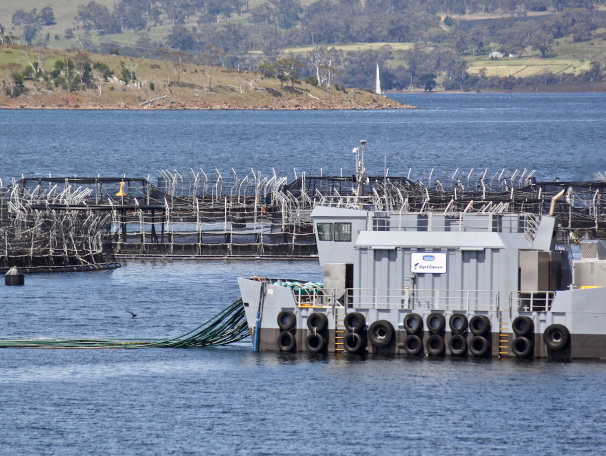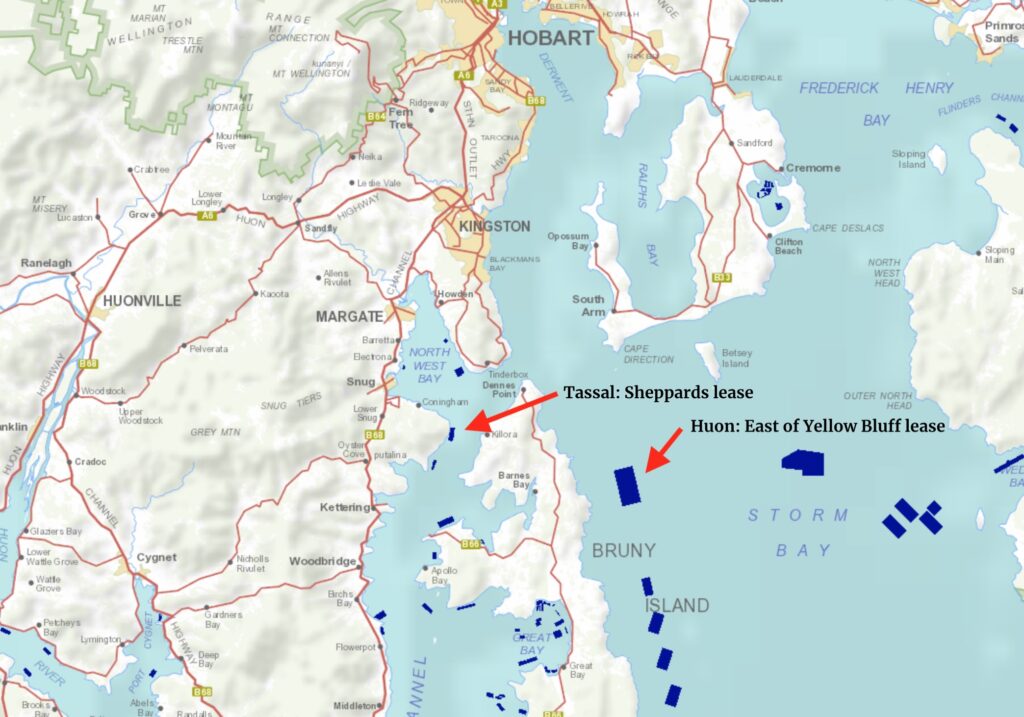Public kept in the dark as more than a tonne of antibiotics used at two Tasmanian salmon farms

More than a tonne of antibiotics was used to control a potentially deadly fish disease at two salmon farms in southern Tasmania earlier this year, but the companies and government made no public announcements at the time.
Reports submitted to the Environment Protection Agency by Tassal and Huon Aquaculture revealed wild fish had scavenged antibiotic-laced pellets below the salmon cages. One sample of three flathead caught off Coningham Beach, two kilometres from the boundary of Tassal’s Sheppards lease, revealed antibiotics in their flesh above the reportable threshold. The monitoring reports were not made public until months after the disease outbreak.
Sheenagh Neill, co-vice chair of Tasmanian Alliance for Marine Protection, said she accidentally discovered the two companies had used antibiotics at the leases. “It is infuriating that the information about these big antibiotic dumps was buried and most likely deliberately so. I accidentally found this information searching for something else, buried deep in the subpages on their website,” she said.
Since 2016, the Tasmanian salmon industry has used more than four tonnes of antibiotics to counter disease outbreaks - enough to treat more than the entire Tasmanian adult population, assuming the medicines were approved for use in Australia.
The controversy over antibiotics follows revelations that Tasmanian salmon contain significant levels of ethoxyquin, a feed additive banned in the European Union over health concerns.
Earlier this year, a Legislative Council report on fin fish farming in Tasmania noted the public expected the “timely” release of information, including on disease outbreaks and the use of antibiotics. It recommended greater disclosure by the government.
Tassal says that when an antibiotic is used, an orange sign will be attached to the affected pens to notify other waterway users. Neill said that was “not useful at all”. “How can someone fishing or swimming at a nearby beach such as Coningham or Nebraska on Bruny, see a sign on a salmon farm two kilometres away or around a headland? The public has a right to be informed in real-time,” she said.
Battling bacteria
The two salmon leases had been affected by Vibrio, a bacterium the Tasmanian Salmonid Growers Association says can cause an infection with a “high mortality rate”. Tassal and Huon Aquaculture did not respond to requests for details on how many salmon died in the outbreak.
The report submitted by Tassal showed that between January 7 and January 20 it fed pellets containing 675 kilograms of a broad-spectrum antibiotic, oxytetracycline, to salmon in 15 cages at its Sheppards lease.
Sampling revealed the antibiotic was detected at levels above the reportable threshold in all the sediment samples taken immediately adjoining the fish cages over an eight week period. The antibiotic was also detected in some sediment samples up to 100 metres from the lease boundary and in the flesh of wild fish caught within and beyond the lease immediately after the two week course of medicated feed.
“If salmon were all vaccinated, then perhaps this would avoid excess use of antibiotics … We need to see a shift to land-based fish farming where operations can be more open.” Ms. Sheenagh Neill.
In late January, Huon Aquaculture fed pellets containing 400 kg of another antibiotic, trimethoprim, to salmon in a dozen cages at its East of Yellow Bluff lease. Its report submitted to the EPA revealed three of the four wild fish samples collected within the lease area immediately after using the medicated feed revealed antibiotics well over the reportable threshold. None of the sediment or fish samples collected over three months later contained antibiotics above the threshold.
The wild fish sampled included benthic species such as sand flathead and pelagic species such as jack mackerel, blue mackerel and barracouta.

A 2015 audit for the Aquaculture Stewardship Council of Tassal’s Sheppards lease reported the company “has avoided directly informing the local community” about the use of antibiotics and potential risks “due to concerns regarding the potential to cause alarm.” Huon Aquaculture posted a brief note on its website over a month after using antibiotics at its East of Yellow Bluff lease off the east coast of Bruny Island.
Petuna, the smallest Tasmanian salmon company, used over 14 kg of oxytetracycline at its Rowella salmon farm in the Tamar River in September last year.
The path not taken
The World Health Organization (WHO) has classed the two antibiotics used by the companies as “highly important” for human health and warned their overuse in the food industry could lead to the development of antibiotic-resistant “superbugs”. A recent report by Monash University for World Animal Protection, an animal welfare non-profit, found potential evidence of antibiotic resistance in 39 percent of 90 samples of Tasmanian salmon bought from supermarkets in Melbourne.
As an alternative to using essential antibiotics, the WHO has recommended the vaccination of farmed animals. The Department of Natural Resources and Environment Tasmania, which has a central role in regulating the salmon industry, has acknowledged vaccines “can eliminate” the need for antibiotics in the salmon industry. Vaccines against vibrio infections have been available since 1988.
Since 2005 it has been a requirement for all salmon farmed in Macquarie Harbour on Tasmania’s west coast to be vaccinated against known diseases in the area, including vibriosis. But the marine farming development plans covering the East of Yellow Bluff and Sheppards leases do not require vaccination against vibriosis.
Huon Aquaculture acknowledged on its website that the salmon at its lease were not vaccinated against vibriosis, but said all future year classes would be. Tassal did not respond to inquiries on whether the salmon at the Sheppards lease were immunised against Vibrio bacteria.
“If salmon were all vaccinated, then perhaps this would avoid excess use of antibiotics … We need to see a shift to land-based fish farming where operations can be more open,” Neill said.
The Tasmanian government plans to finalise biosecurity regulations for the salmon industry later this year, with different standards applying for each of the six zones around the state.
 @BobBurtonoz
@BobBurtonoz